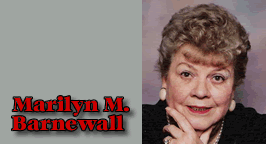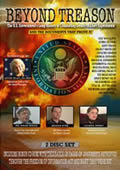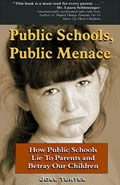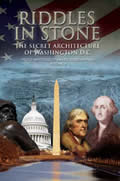By
Marilyn M. Barnewall
July 1, 2012
NewsWithViews.com
People assume because we’ve had fractional-reserve banking around for many years that it’s always been that way. It hasn’t. This article is about the way banking used to be – the way it should be.
This sound like a really dull topic, doesn’t it? Fractional-reserve banking? Who in the world wants to know what it is and how it works? You might want to consider the fact that this thing called “fractional-reserve banking” is at the heart of America’s financial woes and if you want to see new jobs being created, if you want to see our banks on firm ground again, you need to know what it is. You cannot effectively fight a faceless, invisible opponent.
In the “good old days,” commercial banks made loans from the deposits customers placed in checking and savings accounts (and certificates of deposit, etc.). The general consensus was that if you loaned only 70 percent of deposits, you would always have enough cash on hand to deal with the daily needs of people who needed cash. That consensus proved to be true. Other transactions – like clearing checks so people could pay their bills – was a computer transaction that could be cleared at the end of the month. Daily cash wasn’t absolutely necessary for that function.
Regulations were strict and they were enforced… those last three words are key to understanding one of the major reasons for our current financial mess. Today, regulations are not enforced. That is especially true during times the government wants to implement new regulatory controls. They ignore the regulations that are on the books and when things fall apart they demand new regulations be created. Why do they do this? In my opinion, they use this ruse when they need to cover something up… need to pass new regulations that will prevent the public from finding an error or an unlawful action taken – I believe that the Dodd Frank Bill was passed to cover up unlawful foreclosures and all of the actions taken that made foreclosures possible in the first place. Or, like the time the Federal Reserve gave its permission for investment banks to join with commercial banks on Wall Street when the Fed had absolutely no authority over the investment banking community and legally could not take such an action. When they passed legislation to allow the Fed to do what it had done six months earlier, they grandfathered the law to the date of the occurrence.
In other words, when you hear “new regulatory controls,” it should send a shiver up your spine, not provide you with a sense of security or that someone who knows what he or she is doing is in control. If someone who knew what he or she was doing was in control, there would be no need for new regulatory controls.
Back to my “good old days” explanation of how banking worked – and worked well and kept banks from becoming too big to jail and did not create debt at the breathless rate we’ve experienced during the last 20 years.
When banks were lending their own deposits – or, more accurately, your deposits – the only way the bank could grow was – how? Think about it for a minute. If a bank is lending customer deposits and wants to grow, what must the bank do? Answer: It must generate more deposits. What does that mean? How does a bank generate more deposits? There is only one way: Support new business growth within the community (which, in turn, creates new jobs). New companies and their employees place their new deposits in the bank and the bank grows. Audits twice a year keep the loan quality high and the community thrives.
Under the fractional-reserve system, banks pay to the Federal Reserve 10 percent of loans made (the reserve) and are given access to bank credit at the federal funds rate (usually). The fed funds rate has been at ¼ of 1 percent for a rather extensive time – which is also responsible for creating all of those credit bubbles that keep bursting and requiring billions and billions of dollars to stave off a collapse of the banking system.
Banks can borrow up to 90 percent of their loans made at a bargain basement rate and lend those funds to retail customers (car loans, home improvement loans, etc.) and businesses at a much higher rate. The bank may net from 5 to 10 percent more on a loan rate than the funds cost the bank, in other words. If you pay a car loan rate of 10.25 percent and if the bank is borrowing from the Fed at ¼ of 1 percent, the bank is netting 10 percent because the cost of funds from the Federal Reserve is only ¼ of 1 percent.
In the good old days, banks had to pay customers 5 percent on savings deposits and 5.25 percent on time deposits (like certificates of deposit). When they charged you 10.25 percent for a car loan, they only netted 5.25 percent. Since operations costs to run the bank usually run from 2 to 3 percent of the banks total assets (loans), the bank’s profits were from 2 to 3 percent. Why did the banks have to pay customers 5 or 5.25 percent on deposits? Because Regulation Q required them to pay it… the Congress did away with Regulation Q when it passed legislation allowing Merrill Lynch and other brokers to pay any amount of interest they wanted to pay on brokerage deposit accounts. When brokers first began offering money market accounts, Merrill Lynch at one time paid 21 percent on its deposits. See how they use human greed against you?
A very predictable thing happened: So much money was moved from bank checking and savings accounts into the Merrill Lynch money market account, it caused disintermediation (a word that means so much money was removed from banks and savings and loans that no money was available to make loans for housing, cars, and all other consumer credit purchases and it caused a major recession). Now before you begin with the usual “greedy banks!” rhetoric, ask yourself a little more carefully just who was being greedy? There is no justification for deposits that are insured that warrants a 21 percent rate of interest. Those who wanted that kind of return on their deposit dollars could certainly be classified as “greedy.” And bear in mind who was offering this high rate of interest: the investment bankers, not the commercial bankers.
Because disintermediation occurred and banks had no money to loan to businesses and companies had to downsize and unemployment was rising, Congress did away with Regulation Q. To compete effectively, banks were able to offer high rates of return on their deposit accounts, too. That single act made it possible for you to get the lousy rate of return on your deposits today and it doubled the profit potential for bank loans. Please don’t tell me this wasn’t the intention of brokerage houses and the U.S. Congress from the very beginning. It hailed the demise of the savings and loan industry (better to have only two mortgage lenders like Freddie and Fannie that can be controlled rather than thousands of savings and loans that cannot be controlled – at least when you want to implement a mortgage scam). In short, Congress used the greed of the American public to cause disintermediation so it could do away with Regulation Q. Perhaps I wouldn’t be so sure that was the case if a plethora of bank regulations had not followed… regulations that made it possible for the rape of the commercial banking industry and the carefully planned crises that have occurred in the aftermath… the Gramm, Leach, Blyley Act, for example, that did away with the Glass-Steagall Act, allowing commercial and investment banks to merge their services.
Thus was a moral conflict created that made it possible to create mortgage-backed derivatives by the hundreds of trillions of dollars… the primary cause for America’s near financial collapse.
Back to fractional-reserve banking.
Under the fractional-reserve system of banking, what must a bank do to grow? It must generate debt. Just as under the old system of deposit generation banks had to create new deposits to grow, under the new system banks must generate debt to grow.
And that’s how the American economy ended up with debt the rising, featured star in the skies of the commercial banking industry. It’s how you and I ended up paying for Ben Bernanke’s ongoing monetization of the bad debts created by this system. It’s a Ponzi scheme that doesn’t stop – until it all comes tumbling down. Those who say “let it happen” haven’t got a clue as to just how bad things can get when a nation’s entire economic system collapses.
There are several things that can change the road we’re on… primarily a return to the Glass Steagall Act would be good (but will never happen). It would immediately force the removal of J.P. Morgan from Chase Manhattan Bank (and maybe Jamie Dimon would be able to keep track of what’s going on there if it were less complex… prevent more $2 billion – oops, I mean 5 billion – well, maybe I mean $12 billion; no one seems to know the total loss). Suddenly, the bank would no longer be too big to jail – or fail. Next time it performed unlawful functions, we could let it fail – as it should. The same is true of Citigroup and Bank of America.
So many people like to say “Capitalism has failed.”
No it hasn’t. We haven’t had capitalism in the United States for years. What we have is debt capitalism (as I call it) – or, “debtism” as Kirk MacKenzie of Save Rural America suggested I call it. He’s right. “Debtism” is a better name.
Our economic structure is based on “debtism,” not “capitalism.”
| Subscribe to the NewsWithViews Daily News Alerts! |
One thing I do know. The way we used to do banking, a commercial bank could not grow if it did not support business growth in its local community. You can’t get new deposits so you can grow if you don’t help create new businesses and new jobs.
The basis of America’s financial problems is “debtism.” The basis of finding our way out of this mess largely depends on making sure we do not replace one Pied Piper (government) who wants to give us something for nothing – which the people love – for another Pied Piper who also suggests that something for nothing is possible.
If you’ve never looked up the meaning of the word “covet,” you might want to do so. Basically, it means “Thou shalt not put thy hand in thy neighbor’s pocket to take from him/her that which they have earned and you have not.”
� 2012 Marilyn M. Barnewall - All Rights Reserved
Sign Up For Free E-Mail Alerts
Marilyn MacGruder Barnewall began her career in 1956 as a journalist with the Wyoming Eagle in Cheyenne. During her 20 years (plus) as a banker and bank consultant, she wrote extensively for The American Banker, Bank Marketing Magazine, Trust Marketing Magazine, was U.S. Consulting Editor for Private Banker International (London/Dublin), and other major banking industry publications. She has written seven non-fiction books about banking and taught private banking at Colorado University for the American Bankers Association. She has authored seven banking books, one dog book, and two works of fiction (about banking, of course). She has served on numerous Boards in her community.
Barnewall is the former editor of The National Peace Officer Magazine and as a journalist has written guest editorials for the Denver Post, Rocky Mountain News and Newsweek, among others. On the Internet, she has written for News With Views, World Net Daily, Canada Free Press, Christian Business Daily, Business Reform, and others. She has been quoted in Time, Forbes, Wall Street Journal and other national and international publications. She can be found in Who's Who in America, Who's Who of American Women, Who's Who in Finance and Business, and Who's Who in the World.
Web site: http://marilynwrites.blogspot.com
E-Mail: marilynmacg@juno.com











 Share
This Article
Share
This Article



